I've finally completed 33 gallon fuel tank retrofit on my 2020 RAM Rebel. I took that truck from stock inventory at the dealership, and I thought I will be OK with 23 gallon tank, which was a trade-off for a eTorque engine. Man, I love how eTorque works comparing to regular 5.7 HEMI.
My previous SUV had just 14 gallon, and while it was very inconvenient, I was living with it for few years. But then I switched to Dodge Durango with its 25 gallon tank and 21 mpg even going 80mph on a highway. So I easily was going 450-500 miles between fuel stops, and I even changed the way I do road trips taking bio-breaks in parks instead of gas stations. My dog definitely appreciated that change. 23 gallon in Rebel wasn't too small comparing to 25 gallon in Durango, but because of way lower mpg on highway speeds, I needed to stop to refuel every 3 hours. Plus when going to the wilderness, I needed to fill-up at the last gas station, and then hoping that I will have enough fuel to return back. So long story short - I realized that I really need a 33 gallon tank.
Thanks to people in this thread for valuable info. Unfortunately, I couldn't find A-Z guide how to do this upgrade, so it took some time to do my own research. Let's start.
Parts that you need:
1. 68408875AE - 33 gallon fuel tank
2. 68409160AE - fuel pump. Looks like if you have 26 gallon tank you can reuse it, but 23 gallon fuel pump is different. It comes with O-ring seal.
3. 52030458AB and 06104717AA - 3rd fuel tank strap and nut. You need this if you are lucky and you have a subframe member for the 3rd strap, closer to the front of the truck. It is not clear why some trucks with 23 or 26 gallon tanks have it, and some don't.
4. 52029888AC - vapor canister (EVAP). It is longer then vapor canister of 23 gallon tank.
5. 52029909AC - hose from vapor canister to fresh air filter. It is different than the hose from 23 gallon tank.
6. 52029908AB - hose from vapor canister to vapor tube
7. 68307831AB - vapor tube. Connects hose 52029908AB with another vapor tube, going to the engine. It is shorter than 23/26 gallon tank tube.
8. 52030443AB - fuel line bundle. Connects vapor canister, fuel pump and exhaust port on the fuel tank. It is longer than 23/26 gallon tank bundle.
9. 04721916AA - lock ring for fuel pump. Small addition that will save you a lot of time. Instead of reusing the lock ring from an old tank, just put a fresh one to a new tank. Few backs worth the pain of trying to remove an old ring from old tank from my perspective.
10. 68408875AE - skid plate for 33 gallon fuel tank. If you have a skid plate on your 23/26 gallon tank, it is shorter and won't cover ~1 feet of the longer 33 gallon tank.
I was upgrading from 23 gallon tank, I don’t have a frame crossmember for the 3rd strap, and I've decided to keep my short fuel tank skid plate since I don't plan to do crazy rock crawling. Total for parts before tax for me was less than $600, which is OK since 33 gallon tank as an extra option when you order the truck costs $450. Plus 2-3 hours of work if you know what to do.
1. First things that you need to do is to burn as much gas in the tank as you can. When I returned back to my garage, trip computer was showing 20 miles to empty, but actually it appeared that ~3 gallons were still left in the tank. So try to get it to the state when it shows "Low". It will save you time from activating fuel pump through AlfaOBD and draining the remaining gas to the bucket. Plus I didn't relieved the pressure from fuel system, I just let the truck to stay overnight in the garage. So use as much gas as you can and then leave the truck alone for 12 hours, and don't start it when you return back to remove the tank.
2. Remove fuel tank skid plate if you have it by unscrewing 4 bolts.
3. Follow Fuel Tank Replacement Guide to remove the tank. I've skipped steps #1 and #4. I used 4 jack stands to lift the vehicle 0.5 feet above the ground - that was enough to work on this. Then I used floor jack with a piece of 2x6 stud to carefully lower the tank to the ground. With few gallons of gas inside, I think total weight was over 30 pounds, so I suggest to use a buddy to help you with this. Check Fuel Connector chart for more details how to disconnect each connector type.
4. Install new fuel pump by following steps #1-#7 from Fuel Pump Replacement guide.
5. Install new vapor canister on a new tank. Install 52029908AB hose and 52030443AB bundle on the tank, use old tank as a reference how to connect everything.
6. Swap heat shield from old tank to new tank by unclipping 4 plastic clips.
7. Go under the truck and remove vapor tube going to the engine, and replace it with shorter vapor tube (68307831AB). You will need to unclip the plastic mounts holding break lines and a fuel line, be careful not to damage them.
8. Then replace hose that goes from you've disconnected from vapor canister, that goes to fresh air filter. New one is 52029909AC.
9. Install new tank, which is directly opposite to tank removal procedure, nothing special there.
10. If you have a frame crossmember for 3rd strap, install that 3rd strap. My truck didn't have it, and I can't say that tank with 2 straps is not secured well - it is not moving anywhere, and majority of the weight is carried on default two straps just fine. Tank is made of a thick high-density plastic, so it will not crack even under its own weight.
11. Install the skid plate.
12. Lower the truck and fuel it up. I poured 2 gallons from the canister and checked for leaks. Start the truck and make sure it runs well and nothing is leaking. Water drops from the exhaust are water, not gas, so don't freak out if you see them

13. Connect with AlfaOBD and change VehConfig-3 Fuel Capacity to 125, which is the 33 gallon tank volume in liters (default setting for 23 gallon tank is 87). Check
this post for details, thanks Dixit.
14. Go to the gas station and fill up. Enjoy 500+ miles to empty on the trip computer!
If you find this guide useful, check my Amazon influencer page for other items that I use with my RAM:
bit.ly/RAMStuff













